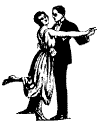 ocial
ocial  istory -- What is it?
istory -- What is it?Some definitions...
 ocial
ocial  istory -- What is it?
istory -- What is it?
 "[The way history was studied] began to change during the 1960s and 1970s. By the 1990s, the change was so profound as to alter the discipline of history almost beyond recognition. Historians increasingly looked past the intensively cultivated fields of public life to the untilled ones of private experience. They developed an interest in the lives of people who generally had not been deemed worthy of attention previously -- of women and children in a patriarchal nation;
of racial minorities in a predominantly
white society; of sharecroppers, and others who fell outside the American middle class. They began to demonstrate an interest in the most intimate details of human experience -- courtship and marriage, birth and death, masculinity and femininity, heterosexuality and homosexuality. In the process, they transformed history from one preoccupied with public men in public life to 'social history.'"
"[The way history was studied] began to change during the 1960s and 1970s. By the 1990s, the change was so profound as to alter the discipline of history almost beyond recognition. Historians increasingly looked past the intensively cultivated fields of public life to the untilled ones of private experience. They developed an interest in the lives of people who generally had not been deemed worthy of attention previously -- of women and children in a patriarchal nation;
of racial minorities in a predominantly
white society; of sharecroppers, and others who fell outside the American middle class. They began to demonstrate an interest in the most intimate details of human experience -- courtship and marriage, birth and death, masculinity and femininity, heterosexuality and homosexuality. In the process, they transformed history from one preoccupied with public men in public life to 'social history.'"
 |
--from David B. Danbom, "Learning Lessons from History," USA Today: The Magazine of the American Scene, Sept. 1999, pp. 30-32. (Available full-text on GALILEO) |

 "Social history has been variously defined: as history 'from the bottom up'; as the history of everyday life; or, as the history of groups and the power relationships between them. History from the bottom up immediately brings to mind images of the working class, black slaves, the poor. The history of everyday life chronicles change over time in the fabric of ordinary existence -- sometimes minute and subtle, occasionally rapid and momentous. Family and the home, labor and the workplace, popular thought and recreation
are among its subjects. Concerning
the interaction between groups, social history prods us to ask questions about the identities that unite and divide us according to such overlapping categories as gender, race, ethnicity, religion, social class, and sexual and political orientation. Social historians explore the relationships between diverse groups, but they also examine how people develop the cultures and ideologies that bind them together or set them at odds."
"Social history has been variously defined: as history 'from the bottom up'; as the history of everyday life; or, as the history of groups and the power relationships between them. History from the bottom up immediately brings to mind images of the working class, black slaves, the poor. The history of everyday life chronicles change over time in the fabric of ordinary existence -- sometimes minute and subtle, occasionally rapid and momentous. Family and the home, labor and the workplace, popular thought and recreation
are among its subjects. Concerning
the interaction between groups, social history prods us to ask questions about the identities that unite and divide us according to such overlapping categories as gender, race, ethnicity, religion, social class, and sexual and political orientation. Social historians explore the relationships between diverse groups, but they also examine how people develop the cultures and ideologies that bind them together or set them at odds."
| --from "Preface," Encyclopedia of American Social History, Cayton, Gorn, and Williams, eds., p. xvii. (This 3-volume set is available in the library's reference room at HN57 .E58 1993.) |  |
